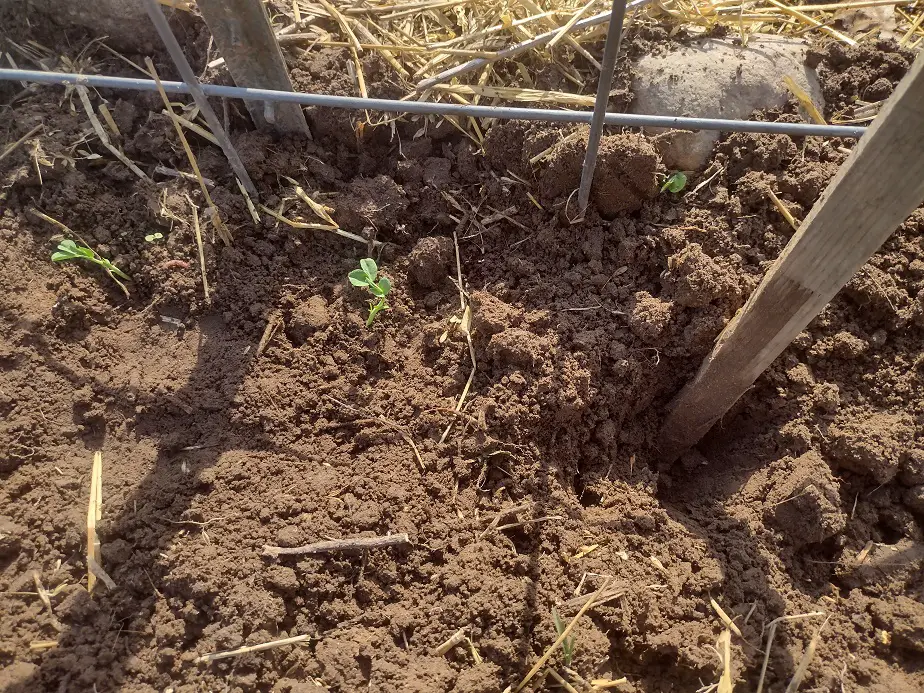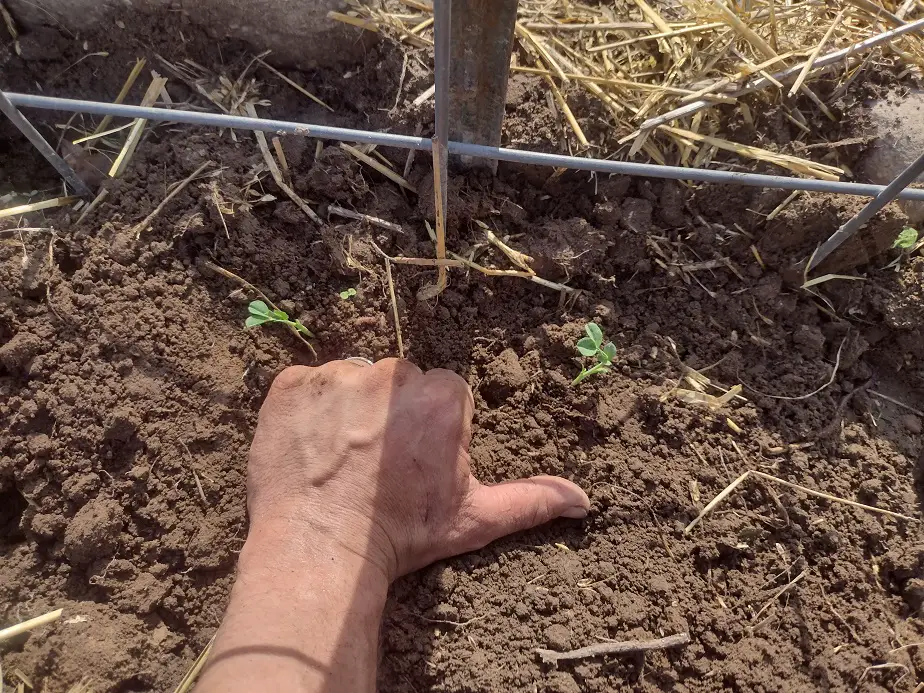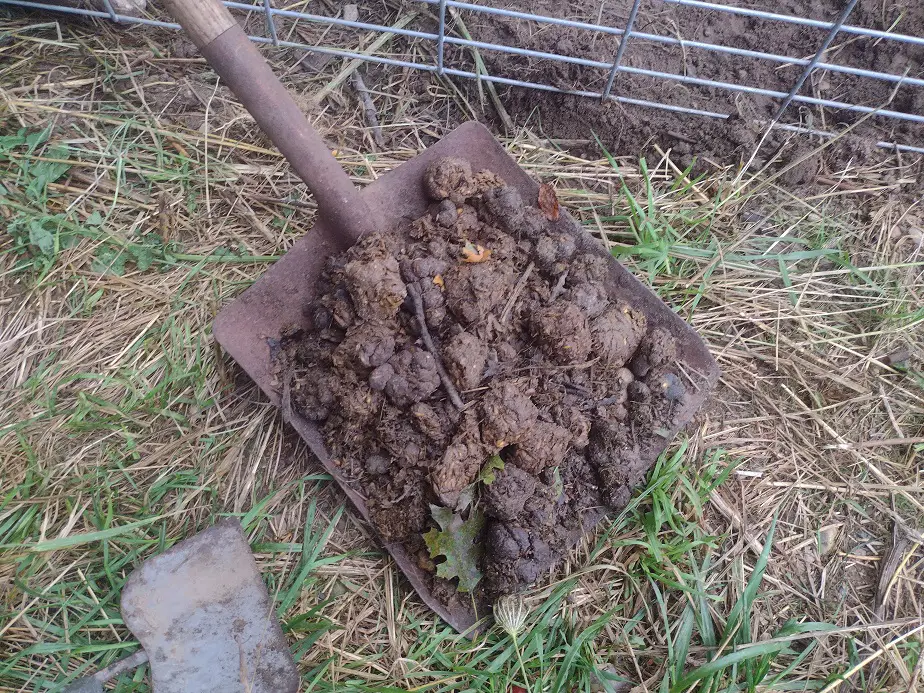Green and shelling beans are the most reliable crop we grow. The hard part is keeping up with picking them.
Beans are usually planted by June 1st in southern Michigan, June 4th in central Michigan, and June 10th in northern Michigan. Wait until the soil temperature has crested 60 degrees and the air temperature will not dip below 50. Beans planted in colder soil will germinate slowly and with poor results.
Beans are fairly simple to grow, but there are some tips and tricks to getting the most flavor and the most growth out of your plants.
Temperature and Weather for Planting Beans
Beans need fairly warm soil, moderate temperatures, and moderate rainfall to grow well. The biggest issues with getting beans to grow in the north are too cold of soil or too much rain in the spring. Beans don’t grow in cold, and they don’t handle wet roots very well.
Regardless of soil temperature, if there’s a week of rain coming, don’t plant your beans until after the rain. Spring rain cools the soil and causes the beans to germinate slower. Slowly germinating seeds have a much higher chance of succumbing to early rot.
Bean plants have shallow roots that need well-aerated soil. Too much water in the dirt for too long can cause the plant’s roots to die off, killing or otherwise hurting the plant. It’s worse for younger plants with smaller root systems.
That’s why soil selection and preparation is such a big deal for beans. The right soil will do a lot to combat this set of problems.
The other side of the spectrum is soil that’s too hot and/or dry. Fortunately, that’s not usually an issue in the north country. But, I’ve run into it. Planting beans in July is tough because the soil can dry out soo much so quickly. Irrigation helps. Again, the right soil will take care of that problem most of the time.

Soil Preparation For Planting Beans
Soil needs to be loose and have good drainage for planting beans. Before planting, the soil needs to be amended to a moderate fertility level. It’s always smart to add some extra organic matter into the soil before planting the seeds.
I like to work a heavy dose of compost or a moderate dose of manure into the soil a month before planting beans, then do a fertility test just before planting. I will caution against overworking the soil. Soil disturbance is the biggest factor in the loss of natural fertility. Don’t overwork the soil, it kills topsoil.
I like to rake up my soil before planting. I don’t use the rototiller for soil preparation. Just hoe or flame the weeds, and rake it smooth. As far as working in manure or compost, I just use the rake for the most part. If manure is really clumpy, I’ll break it up with the hoe. Compost is just sprinkled on the ground.
Chunks of manure sitting on the soil won’t hurt anything. It will act like a mulch and help keep the soil moist and it will break down over time. It will still allow nutrients to work into the soil and it will still break down. Most of the time, just raking the soil will be enough to adequately prep the topsoil.
Deeper tilling mixes up the topsoil with the subsoil layers and waters down the topsoil’s fertility. Having a weaker or more spread-out topsoil cause sool to dry iot faster and be less biologically active.
One of the things that I like to do to the soil before planting is to add some alfalfa meal to the soil. Just sprinkle on and it will really add to the fertility of the topsoil. A cheaper version is rabbit feed. It’s mostly alfalfa and will work in a pinch. It does have a little salt in it, but not really enough to make an issue.
If your soil is very sticky and heavy and it hasn’t been raining, add organic matter. Be that manure, leaves, grass clippings, compost; or anything like that. That’s when I’ll get the rototiller or use a hoe and shovel to till deeply. Do the same for very sandy or light colored soil.
The organic matter will immediately improve the drainage and texture of your soil, and given some time it will improve the natural fertility and biological function within the soil. You can do a lot to fix this sort of issue in the off-season. Layer on organic matter nice and deep and let it break down until spring.

Spacing and Planting Depth
Beans are planted between 1 and 2 inches deep, but the best depth depends on your soil. Plant beans 1 inch deep in fine-textured soil or 2 inches deep in sandy soil. That will help the seed stay moist and sprout, but not have a hard time breaking ground as it germinates.
I like to plant my beans 6 inches apart. Much closer than thet abd they get pretty grown together and tough to pick. When the soil is soft, moist, and weed-free, plant them. I like to plant three rows one foot apart. If I want more than three rows, I put extra space between every 3rd row so I have room enough to walk down and pick them.
I plant most of my beans by hand and use my finger as a depth gauge. The first knuckle is an inch, the second is about two inches. I go down the line poking holes, dropping beans in, and covering them up. Don’t tamp the soil much after planting, just cover and pat down gently.
Don’t mulch your soil until after the beans have at least one set of true leaves. The plant needs to begin photosynthesizing as much and as soon as possible. Your seedlings are going to struggle if the soil is covered too deeply in the beginning.
As long as your soil is decent, seeds are planted appropriately, and the soil has food and water for the plants, you will probably grow great beans.

Watering and Fertilizing Beans
Beans often do well with a balanced fertilizer like 10-10-10, but don’t really need that much phosphorus. A more adequate NPK ratio would be something like 11-3-10. A phosphorus-free fertilizer may be well warranted to grow beans in a garden.
Beans need between 40 and 80 pounds of N per acre. On average, they are fertilized about half as heavily as pumpkins and at about the same ratio of nutrients. Although beans are usually said to not need much fertilizer, if picked heavily they can use up a good amount of potassium, calcium, and magnesium.
Do a simple DIY soil test (I like the Lusterleaf 1601 soil test kit) and see if any macronutrients are lacking or are in excess. A lot of old gardens have an excess of phosphorus already. Too much of that can cause problems. If that’s the case, find a Phosphorus free fertilizer.
Ideal results with that soil test kit is right at halfway, or a bit below. Too little fertility will yield small pants with few beans. Too much nitrogen causes beans to stay in the primary growth stage and not set blossoms, which results in no or few beans. A bit too little is better than too much.
In good garden soil, the average amount of 10-10-10 fertilizer for beans is about 1-1/2 ounces per 10 square feet of planting space. I like measuring by weight because it’s more accurate than teaspoons or tablespoons. This amount is equivalent to 60 pounds nitrogen per acre.
Beans need ample soil moisture and they don’t tolerate dry very soil too well. They need to stay hydrated. Young plants dry out quickly. Seedlings can dry out in a day if the soil goes dry. Check the dirt at the depth the seeds were planted and see if it’s still moist at that depth. If not, you’d better irrigate.
When you do irrigate, you want to put down a good inch of water at a time. The easiest way to monitor the amount of water is to place a bucket or two in the garden and check to see how much water they’ve collected. An inch of water is the minimum for a good watering and it should last a while.
Tips for Picking Beans
Pick green beans when they are as fat as a pencil. When they are proper size, you have about three days to pick them before they start getting too big. Big beans get tough and often develop a stringy texture. When beans are in full swing, you’ll want to pick them at least twice a week.
Pick beans heavily and check every single plant well. I can’t tell you how many times I have gone out after someone picked the beans just to fill up another basket or two with perfectly sized green beans. If they get too big for eating, you can leave a few plants full of beans to mature for seed.
Or, you can just pick them anyways so new blossoms will form and more beans will grow. When you pick beans, it’s easy to rip part of the plant off with the bean. You can use your thumbnail to pinch the beans off so the main stem won’t get damaged.
Picking beans when the plants are wet can encourage plant viral infections in the plants. It’s smart to avoid picking right after a rain or in the morning dew if you can.
Related Articles:

